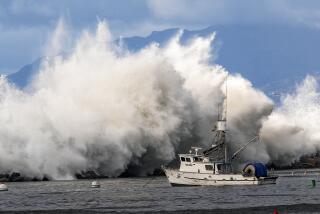No Ebb Tide for El Nino as Current Strengthens Again
The El Nino current wreaking havoc with the worldâs weather is resurging with new strength across the tropical Pacific Ocean, according to satellite data released Thursday by NASAâs Jet Propulsion Laboratory.
The new satellite measurements, which show the current regaining momentum after receding dramatically late last month, bolster federal forecasts of a fierce, tempestuous winter, climate experts said. Drawn from the Topex/Poseidon satellite, the images indicate that El Nino grew by 10% in the first 10 days of December after shrinking by the same amount at the end of November.
The JPL data also offer NASA researchers a glimpse of what they called the heartbeat of El Nino--the way the current ebbs as its energy drains into the atmosphere and then grows again as it is rejuvenated by periodic bursts of strong westward winds in the central Pacific.
âThis takes you right into the heartbeat of El Nino,â said JPL research oceanographer Bill Patzert. âThe El Nino is pulsing. As long as we have this pulsing, that means this baby is going to stay around.
âEl Nino is going to enter 1998 at full strength.â
At the same time, a new survey of global temperatures offers the first detailed look at how El Nino is affecting the atmosphere. It shows that the warm water--a kind of floating hot plate roughly twice the size of the United States--has heated a blanket of air stretching from the eastern Pacific and across the Atlantic Ocean from Cuba to Libya, according to researchers at the University of Alabama at Huntsville.
The atmospheric energy generated by the El Nino current has stirred dramatic global disparities, with November temperatures over the Arctic coast of northwest Canada running 13.5 degrees Fahrenheit above normal, while Siberia was as much as 10 degrees below seasonal norms, the scientists said.
That warm air is elbowing aside normal seasonal weather patterns and fueling severe storm systems across both hemispheres.
El Ninoâs effect on the subtropical jet stream cut the number of Atlantic hurricanes in half this year; while in the Pacific, the energy from its unusually broad pool of warm water allowed severe storms to form closer to the U.S. mainland than usual, resulting in more major storms battering Mexico.
Federal forecasters say the worst is yet to come.
The most recent El Nino advisory from the National Oceanic and Atmospheric Administration predicts that this El Nino--the largest this century--will persist at least until March before weakening.
Some experts, however, are reserving judgment. They are not sure whether this El Nino will live up to its billing as an even more destructive event than the El Nino of 1982-83, which devastated parts of the California coast and caused $10 billion in damage worldwide.
âI wonder how the overall forecast is going to pan out,â said Kevin Trenberth, head of climate analysis at the National Center for Atmospheric Research in Boulder, Colo. âThe effects in the tropics have been enormous but the effects in middle latitudes have not been as pronounced as in the â82-â83 event.â
To further confound experts trying to predict the effects of El Nino, a survey of the average global temperature so far suggests that 1997 overall may be among the coldest years on record, the Huntsville scientists said. Global temperatures have reached seasonal norms in only three of the past 11 months.
The Alabama researchers used data gathered by microwave sounding units on the National Oceanic and Atmospheric Administrationâs satellites to get accurate temperature readings for almost all regions of Earth. The instruments measure the temperature of the atmosphere from the surface to an altitude of almost five miles.
Despite a decade of intense study from orbit and on the sea, no one knows what causes an El Nino event.
Part of what some researchers now suspect is a decades-long cycle of climate change in the Pacific Ocean, the phenomenon is born every few years of a dance between the wind and water, when the tropical trade winds abate and a large mass of warm water normally located near Australia can expand along the equatorial Pacific as far east as Ecuador and Peru.
The JPL data is helping researchers better understand how--once an El Nino has formed--the energy that powers it is replenished by westward winds, even as its heat continually bleeds off into the atmosphere.
âWe were able to identify the cause of all these fluctuations,â said Lee-Lueng Fu, chief scientist for the joint U.S.-French Topex/Poseidon satellite project.
âEach peak can be identified with a west wind burst in the central Pacific,â he said. âThese winds from the west keep it pulsing and keep putting fuel into the El Nino.â
* RAIN IN L.A. BASIN: Storm leaves thousands without power, snarls traffic. B5
(BEGIN TEXT OF INFOBOX / INFOGRAPHIC)
Heartbeat of El Nino
Scientists at NASAâs Jet Propulsion Laboratory have observed a rhythmic pulse in the warm-water phenomenon known as El Nino, occurring every 30 to 50 days. Images from the Topex/Poseidon satellite show changes, white areas above, between Nov. 10 and Dec. 10. In the cycle, El Nino contracts about 10% to 15%, only to be replenished weeks later.
NOV. 10
DEC. 1
DEC. 10
1) El Nino waters ebb as they lose heat to the atmosphere.
2) Winds from the Central Pacific re-energize the current
More to Read
Sign up for Essential California
The most important California stories and recommendations in your inbox every morning.
You may occasionally receive promotional content from the Los Angeles Times.










